Abstract
An antiserum (WA-SAA) was produced which agglutinated specifically with mouse-virulent but not with avirulent strains of Yersinia enterocolitica. Expression of the antigenic determinant(s) reaction with WA-SAA was temperature dependent; for growth temperatures of 20 to 40 degrees C, agglutination titers were lowest for cultures grown at 20 degrees C and highest for cultures grown at 35 to 40 degrees C. Addition of Ca2+ (2.5 to 10 mM) to the growth medium had little effect on the agglutination titer, and gel diffusion studies with monospecific anti-V serum indicated that V antigen was not likely to be the determinant reacting with WA-SAA. Immunohistological studies of Peyer's patches of mice infected with Y. enterocolitica WA revealed that the antigenic determinant(s) reacting with WA-SAA was expressed in vivo. The strong correlation of agglutination titer with mouse virulence and the expression in vivo of the antigenic determinant(s) reacting with WA-SAA suggest that the antigen(s) may be associated with the pathogenicity of Y. enterocolitica.
Full text
PDF
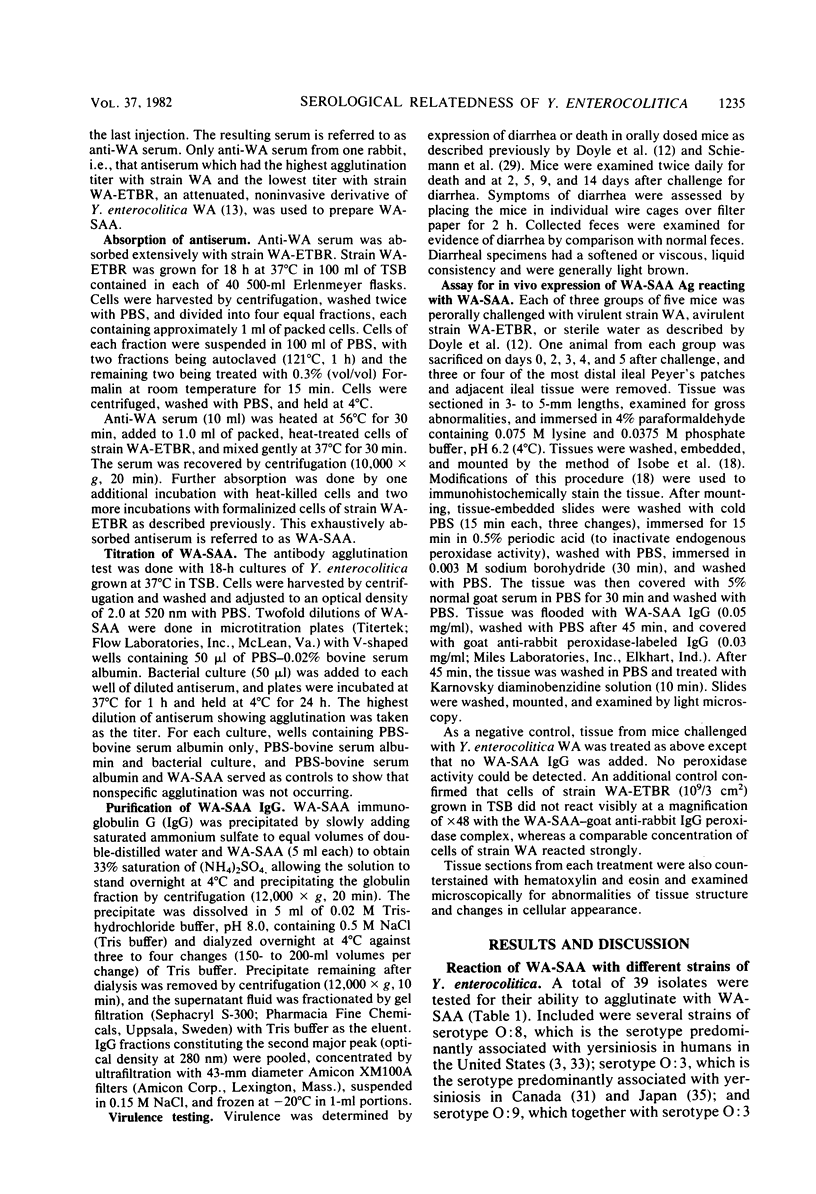
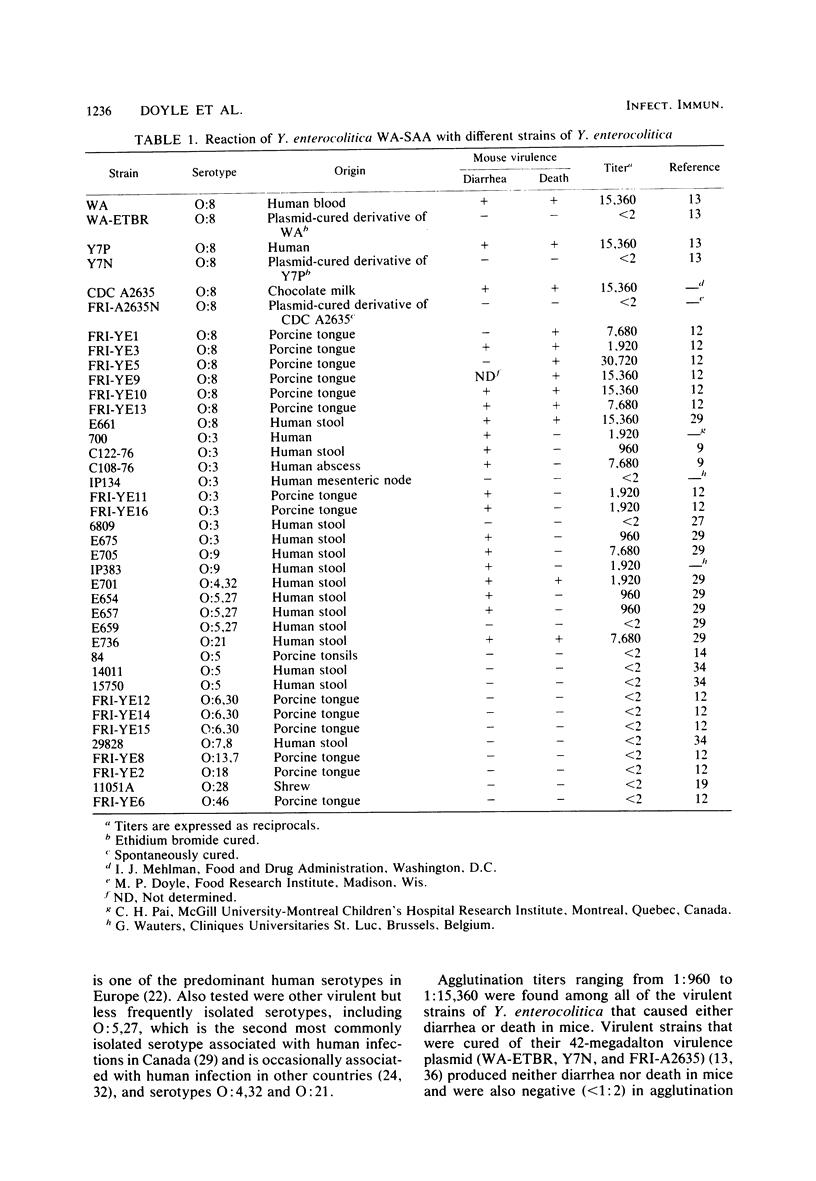

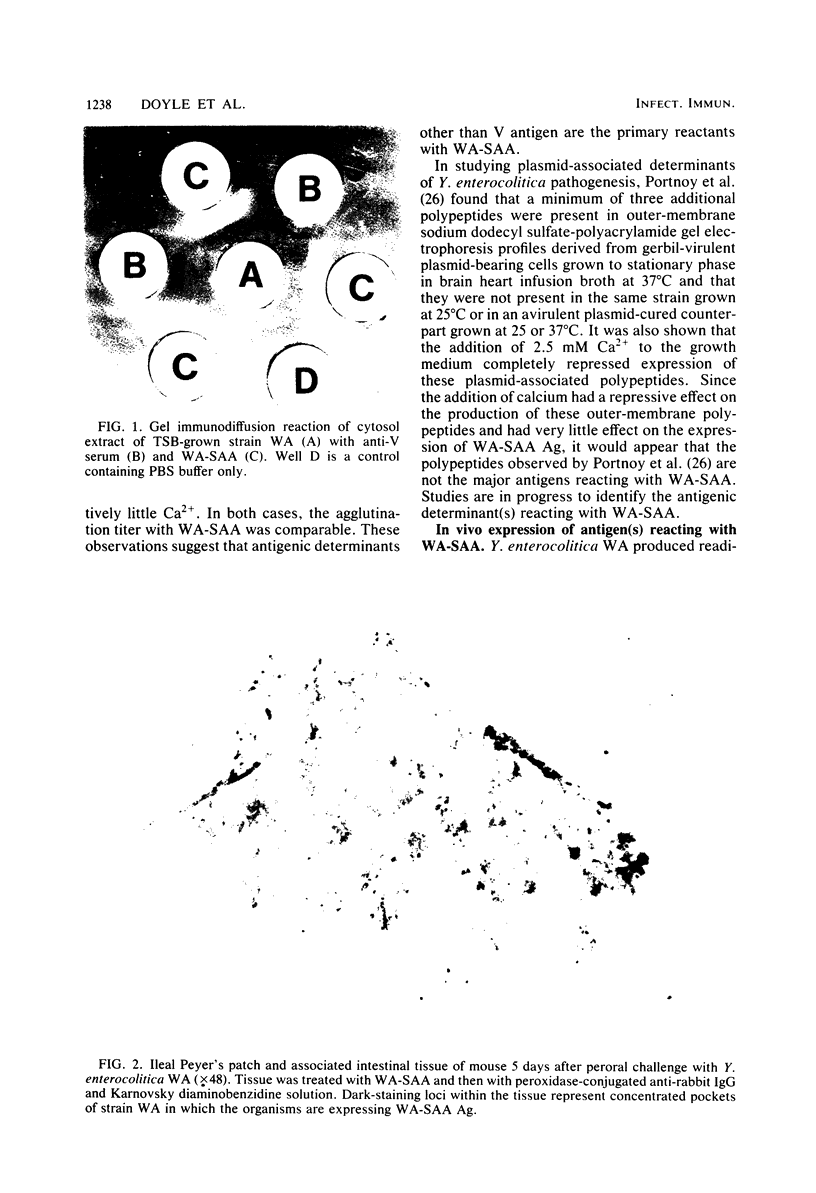
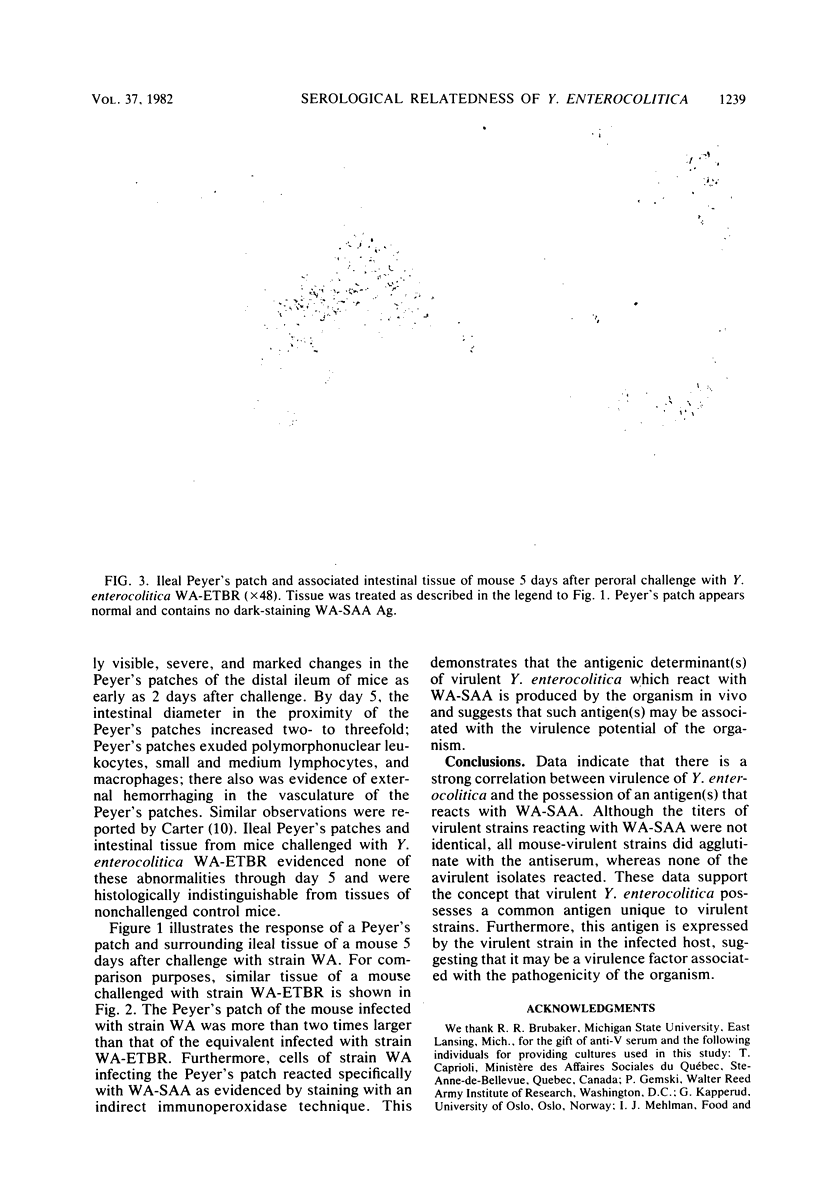
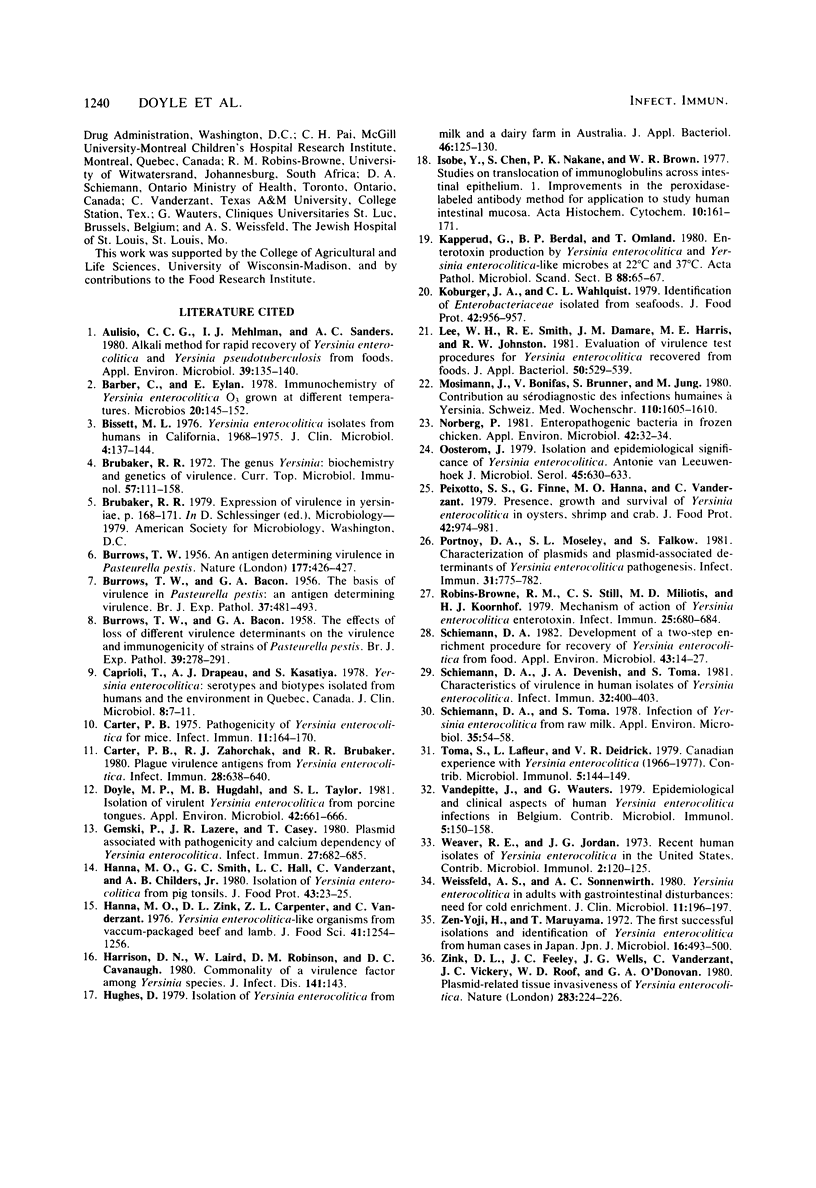
Images in this article
Selected References
These references are in PubMed. This may not be the complete list of references from this article.
- Aulisio C. C., Mehlman I. J., Sanders A. C. Alkali method for rapid recovery of Yersinia enterocolitica and Yersinia pseudotuberculosis from foods. Appl Environ Microbiol. 1980 Jan;39(1):135–140. doi: 10.1128/aem.39.1.135-140.1980. [DOI] [PMC free article] [PubMed] [Google Scholar]
- BACON G. A., BURROWS T. W. The basis of virulence in Pasteurella pestis: an antigen determining virulence. Br J Exp Pathol. 1956 Oct;37(5):481–493. [PMC free article] [PubMed] [Google Scholar]
- BURROWS T. W. An antigen determining virulence in Pasteurella pestis. Nature. 1956 Mar 3;177(4505):426–427. doi: 10.1038/177426b0. [DOI] [PubMed] [Google Scholar]
- BURROWS T. W., BACON G. A. The effects of loss of different virulence determinants on the virulence and immunogenicity of strains of Pasteurella pestis. Br J Exp Pathol. 1958 Jun;39(3):278–291. [PMC free article] [PubMed] [Google Scholar]
- Barber C., Eylan E. Immunochemistry of Yersinia enterocolitica O3 grown at different temperatures. Microbios. 1977;20(81-82):145–152. [PubMed] [Google Scholar]
- Bissett M. L. Yersinia enterocolitica isolates from humans in California, 1968-1975. J Clin Microbiol. 1976 Aug;4(2):137–144. doi: 10.1128/jcm.4.2.137-144.1976. [DOI] [PMC free article] [PubMed] [Google Scholar]
- Brubaker R. R. The genus Yersinia: biochemistry and genetics of virulence. Curr Top Microbiol Immunol. 1972;57:111–158. doi: 10.1007/978-3-642-65297-4_4. [DOI] [PubMed] [Google Scholar]
- Caprioli T., Drapeau A. J., Kasatiya S. Yersinia enterocolitica: serotypes and biotypes isolated from humans and the environment in Quebec, Canada. J Clin Microbiol. 1978 Jul;8(1):7–11. doi: 10.1128/jcm.8.1.7-11.1978. [DOI] [PMC free article] [PubMed] [Google Scholar]
- Carter P. B. Pathogenecity of Yersinia enterocolitica for mice. Infect Immun. 1975 Jan;11(1):164–170. doi: 10.1128/iai.11.1.164-170.1975. [DOI] [PMC free article] [PubMed] [Google Scholar]
- Carter P. B., Zahorchak R. J., Brubaker R. R. Plague virulence antigens from Yersinia enterocolitica. Infect Immun. 1980 May;28(2):638–640. doi: 10.1128/iai.28.2.638-640.1980. [DOI] [PMC free article] [PubMed] [Google Scholar]
- Doyle M. P., Hugdahl M. B., Taylor S. L. Isolation of virulent Yersinia enterocolitica from porcine tongues. Appl Environ Microbiol. 1981 Oct;42(4):661–666. doi: 10.1128/aem.42.4.661-666.1981. [DOI] [PMC free article] [PubMed] [Google Scholar]
- Gemski P., Lazere J. R., Casey T. Plasmid associated with pathogenicity and calcium dependency of Yersinia enterocolitica. Infect Immun. 1980 Feb;27(2):682–685. doi: 10.1128/iai.27.2.682-685.1980. [DOI] [PMC free article] [PubMed] [Google Scholar]
- Hughes D. Isolation of Yersinia enterocolitica from milk and a dairy farm in Australia. J Appl Bacteriol. 1979 Feb;46(1):125–130. doi: 10.1111/j.1365-2672.1979.tb02589.x. [DOI] [PubMed] [Google Scholar]
- Kapperud G., Berdal B. P., Omland T. Enterotoxin production by Yersinia enterocolitica and Yersinia enterocolitica-like microbes at 22 degrees C and 37 degrees C. Acta Pathol Microbiol Scand B. 1980 Feb;88(1):65–67. doi: 10.1111/j.1699-0463.1980.tb02606.x. [DOI] [PubMed] [Google Scholar]
- Lee W. H., Smith R. E., Damaré J. M., Harris M. E., Johnston R. W. Evaluation of virulence test procedures for Yersinia enterocolitica recovered from foods. J Appl Bacteriol. 1981 Jun;50(3):529–539. doi: 10.1111/j.1365-2672.1981.tb04255.x. [DOI] [PubMed] [Google Scholar]
- Mosimann J., Bonifas V., Brunner S., Jung M. Contribution au sérodiagnostic des infections humaines à Yersinia. Résultats préliminaires. Schweiz Med Wochenschr. 1980 Nov 1;110(44):1605–1610. [PubMed] [Google Scholar]
- Norberg P. Enteropathogenic bacteria in frozen chicken. Appl Environ Microbiol. 1981 Jul;42(1):32–34. doi: 10.1128/aem.42.1.32-34.1981. [DOI] [PMC free article] [PubMed] [Google Scholar]
- Portnoy D. A., Moseley S. L., Falkow S. Characterization of plasmids and plasmid-associated determinants of Yersinia enterocolitica pathogenesis. Infect Immun. 1981 Feb;31(2):775–782. doi: 10.1128/iai.31.2.775-782.1981. [DOI] [PMC free article] [PubMed] [Google Scholar]
- Robins-Browne R. M., Still C. S., Miliotis M. D., Koornhof H. J. Mechanism of action of Yersinia enterocolitica enterotoxin. Infect Immun. 1979 Aug;25(2):680–684. doi: 10.1128/iai.25.2.680-684.1979. [DOI] [PMC free article] [PubMed] [Google Scholar]
- Schiemann D. A. Development of a two-step enrichment procedure for recovery of Yersinia enterocolitica from food. Appl Environ Microbiol. 1982 Jan;43(1):14–27. doi: 10.1128/aem.43.1.14-27.1982. [DOI] [PMC free article] [PubMed] [Google Scholar]
- Schiemann D. A., Devenish J. A., Toma S. Characteristics of virulence in human isolates of Yersinia enterocolitica. Infect Immun. 1981 Apr;32(1):400–403. doi: 10.1128/iai.32.1.400-403.1981. [DOI] [PMC free article] [PubMed] [Google Scholar]
- Schiemann D. A., Toma S. Isolation of Yersinia enterocolitica from raw milk. Appl Environ Microbiol. 1978 Jan;35(1):54–58. doi: 10.1128/aem.35.1.54-58.1978. [DOI] [PMC free article] [PubMed] [Google Scholar]
- Toma S., Lafleur L., Deidrick V. R. Canadian experience with Yersinia enterocolitica (1966--1977). Contrib Microbiol Immunol. 1979;5:144–149. [PubMed] [Google Scholar]
- Vandepitte J., Wauters G. Epidemiological and clinical aspects of human Yersinia enterocolitica infections in Belgium. Contrib Microbiol Immunol. 1979;5:150–158. [PubMed] [Google Scholar]
- Weissfeld A. S., Sonnenwirth A. C. Yersinia enterocolitica in adults with gastrointestinal disturbances: need for cold enrichment. J Clin Microbiol. 1980 Feb;11(2):196–197. doi: 10.1128/jcm.11.2.196-197.1980. [DOI] [PMC free article] [PubMed] [Google Scholar]
- Zen-Yoji H., Maruyama T. The first successful isolations and identification of Yersinia enterocolitica from human cases in Japan. Jpn J Microbiol. 1972 Nov;16(6):493–500. doi: 10.1111/j.1348-0421.1972.tb00689.x. [DOI] [PubMed] [Google Scholar]
- Zink D. L., Feeley J. C., Wells J. G., Vanderzant C., Vickery J. C., Roof W. D., O'Donovan G. A. Plasmid-mediated tissue invasiveness in Yersinia enterocolitica. Nature. 1980 Jan 10;283(5743):224–226. doi: 10.1038/283224a0. [DOI] [PubMed] [Google Scholar]





